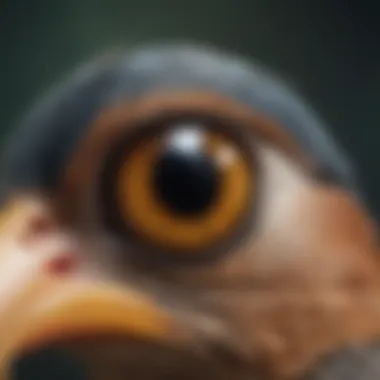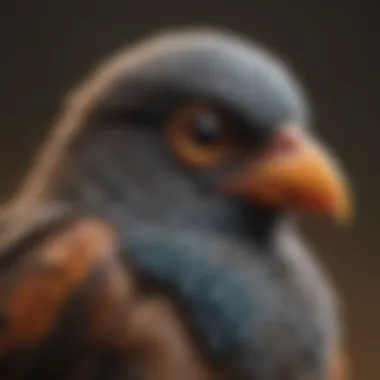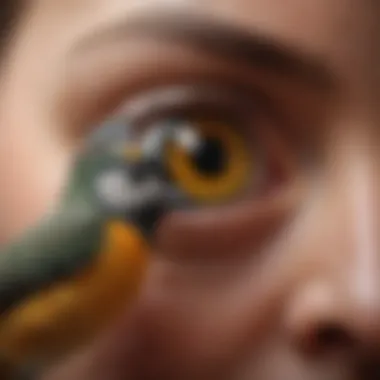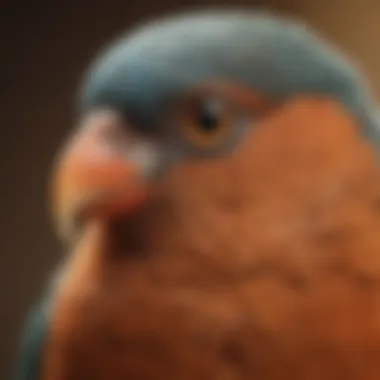Understanding Pet Bird Eye Infections: Causes and Care


Intro
Pet birds are not just companions; they are part of the family. Their well-being is of utmost importance to owners. One of the most concerning health issues that pet birds can face is eye infections. These infections can arise from various causes and can lead to serious complications if not addressed adequately. Understanding the nature of these infections, their symptoms, treatment options, and prevention strategies can empower bird owners to safeguard the health of their feathered friends.
This article will delve into the types of eye infections that affect pet birds, exploring everything from the underlying reasons for these infections to effective treatment and prevention techniques. Comprehensive insights into the daily care routines, hygiene practices, and the significance of routine veterinary check-ups will also be discussed. Ultimately, knowing how to keep avian eyes healthy contributes significantly to a longer, happier life for pet birds.
Prologue to Eye Infections in Pet Birds
Eye infections in pet birds are a critical issue that can compromise their overall health. As bird owners, understanding these infections is essential for ensuring the well-being of our avian companions. An eye infection may seem minor at first, but it can lead to serious complications if left untreated. The eyes are vital sensory organs for birds, making eye health a priority in avian care.
This section delves into the definition and significance of eye infections for pet birds. By comprehending these aspects, bird owners can be more aware of potential risks and the importance of prompt medical attention.
Defining Eye Infections
Eye infections in birds can be identified as inflammatory or infectious diseases affecting the ocular structures. These infections may result from a variety of pathogens, including bacteria, viruses, fungi, and parasites. It is crucial to note that eye infections can manifest in different forms, such as conjunctivitis, keratitis, or even more severe ocular conditions. Identifying the specific type of infection is essential for effective treatment.
The symptoms of eye infections are diverse, ranging from mild discharge and redness to severe swelling and pain. If you notice any unusual signs or behaviors in your pet bird, it is vital to consult a veterinarian to obtain an accurate diagnosis and appropriate treatment plan.
Significance of Eye Health
Maintaining good eye health in pet birds is essential for several reasons. First, the eyes play an integral role in a bird’s interaction with its environment. Impaired vision due to infections can lead to disorientation and increased susceptibility to accidents. Second, infections can spread to other parts of the body, causing systemic illness.
Moreover, healthy eyes contribute to a bird's quality of life. Birds utilize vision for social interactions, finding food, and navigating their surroundings. Addressing eye infections promptly ensures they live comfortably and lowers the risk of more serious health issues.
Ultimately, understanding the significance of eye health can empower pet owners to take proactive measures. Regular veterinary check-ups and the observation of any behavioral changes can foster early detection and intervention, safeguarding the health of your feathered friend.
Types of Eye Infections in Birds
Understanding the various types of eye infections in birds is crucial for pet owners. Eye infections can lead to serious health issues if left untreated. Knowledge of different types helps in early detection and appropriate treatment. There are four main categories: bacterial, viral, fungal, and parasitic infections. Each type has distinct causes, symptoms, and treatment options. This section aims to clarify these types, providing essential information for bird owners to protect their companions.
Bacterial Infections
Bacterial infections are among the most common types affecting pet birds. They may arise from poor hygiene or injury to the eye. Birds can contract these infections through various bacteria, such as Staphylococcus or Pseudomonas. These pathogens can thrive in dirty environments or when the bird's immune system is compromised.
Typical symptoms of a bacterial infection include redness, swelling, and discharge from the eye. Prompt veterinary attention is necessary to avoid more severe consequences. Treatment usually involves antibiotics prescribed by veterinarians. Regular cleanliness in the bird’s environment can help reduce the risk of bacterial infections.
Viral Infections
Viral infections in birds are less common but can be just as serious as bacterial ones. Viruses such as the avian herpes virus can lead to significant eye problems. These infections are often more difficult to treat because antiviral medications are limited.
Symptoms of viral eye infections might include watery eyes, squinting, and changes in behavior. Often, a marked lethargy accompanies these signs. Keeping the bird isolated from healthy ones is crucial to prevent spreading the virus. Supportive care may become necessary to alleviate symptoms, although recovery largely depends on the bird's immune response.
Fungal Infections
Fungal infections occur when fungal spores enter the eye. Aspergillus is a common mold that can cause eye issues in birds. These infections typically arise in environments with high humidity and poor ventilation.
Signs of fungal infections include a cloudy appearance in the eye, swelling, and sometimes discharge. Treatment includes antifungal medications, which may require veterinary supervision. Addressing environmental factors is also critical here, as proper humidity control and cleanliness can prevent future occurrences.
Parasitic Infections
Parasitic infections are another consideration for pet bird eye health. Common parasites such as mites or worms can affect avian vision. These parasites may cause irritation, inflammation, or even severe injury to the eye.
Symptoms often include excessive blinking, watery discharge, or visible irritation inside the eye. If a parasitic infection is suspected, a vet can conduct tests to confirm the presence of parasites. Treatments may involve anti-parasitic medications and environmental cleaning to eliminate any sources of infestation.
In summary, being aware of the different types of eye infections is essential for pet bird owners. Each category has specific symptoms and treatment methods. Understanding these can significantly enhance the chances of quick recovery for affected birds.
Common Causes of Eye Infections
Understanding the common causes of eye infections in pet birds is vital for bird owners. Knowledge of these causes can help in prevention and early detection, thereby promoting the overall health of avian companions. Birds may be vulnerable to various environmental and nutritional influences that contribute to eye infections. Addressing these factors is essential for reducing their risk.
Environmental Factors
Environmental conditions play a significant role in the health of pet birds. Poor hygiene can lead to bacterial growth around the eyes. Dusty or smoky environments can also irritate the eyes and make them more susceptible to infection. Keeping birdcages clean will help in reducing exposure to pathogens that cause these infections.
Other influences include temperature fluctuations and humidity levels. Birds require specific living conditions to thrive. Ideal environments allow for good airflow and maintain stable temperatures. A well-ventilated habitat can significantly decrease the risk of eye infections.


Nutritional Deficiencies
Nutritional aspects greatly impact the immune system of pet birds. Lack of essential vitamins can lead to weakened defenses against infections. For instance, vitamin A is crucial for maintaining healthy eyes. A diet lacking in this nutrient can result in various eye problems.
Providing a balanced diet rich in vitamins and minerals is crucial. Supplements might also be necessary for birds that are picky eaters or have specific dietary restrictions. Monitoring their nutrition can help prevent infections and promote overall health.
Genetic Predispositions
Some birds may be genetically predisposed to eye infections. Certain breeds may have anatomical features that make them more vulnerable. For example, brachycephalic birds might experience eye issues due to their facial structure. In such cases, genetic factors can increase the likelihood of infections. Regular veterinary visits can help identify these predispositions and implement necessary care plans.
By understanding these common causes, bird owners can take proactive steps to safeguard their pets' health. Preventive measures rooted in knowledge and attentive care will go a long way.
Identifying Symptoms of Eye Infections
Recognizing the symptoms of eye infections in pet birds is crucial. Early identification can make a significant difference in treatment outcomes and overall health. Birds are known for their subtle behaviors, which may mask serious health issues. Therefore, being vigilant about eye health is essential for every bird owner, aspiring parent, and breeder.
Physical Signs
Physical signs of eye infections in birds can be quite evident upon close inspection. Here are some common symptoms to watch for:
- Redness or Swelling: Any unusual redness around the eye is often a clear indicator of an issue. Swelling of the eyelids or surrounding tissues can signal an infection needing evaluation.
- Discharge: A discharge that is colored or has an unpleasant smell can suggest a bacterial or viral infection. Healthy birds typically do not have any discharge, so this should not be ignored.
- Closed Eyes: If your bird keeps one or both eyes closed for extended periods, it might be in discomfort. This could be due to irritation, pain, or swelling associated with an eye infection.
- Corneal Cloudiness: The clarity of the cornea is vital for vision. A cloudy or hazy appearance can indicate serious problems such as ulcers or infections.
“Observing the eyes closely can provide crucial hints about your bird’s health.”
Behavioral Changes
Behavioral changes can also indicate an underlying eye infection. Birds are creatures of habit, and any deviations from normal behavior can signal a problem. Consider these signs:
- Reduced Activity: If your bird is sleeping more than usual or seems less playful, this could suggest it is not feeling well.
- Avoidance of Light: Birds may avoid bright areas if they have eye discomfort. Covering the cage or adjusting lighting may help, but it is essential to check for underlying health issues.
- Irregular Eating and Drinking Habits: Affected birds may show a decreased appetite or refuse food altogether. They might also drink less due to feeling unwell.
- Irritability or Aggression: Changes in temperament, such as increased aggression or irritability, could be signs that a bird is in pain or discomfort.
When observing these symptoms, it is valuable to keep a record. Noting these changes can assist your veterinarian in making an accurate diagnosis.
In summary, identifying symptoms of eye infections in pet birds requires careful observation of both physical signs and behavioral changes. By being diligent, pet owners can facilitate timely veterinary interventions, ensuring their birds maintain optimal health.
Diagnosis of Eye Infections
The diagnosis of eye infections in pet birds is an essential part of ensuring their overall health. This process involves identifying specific infections through careful examination and testing. A correct diagnosis sets the foundation for effective treatment and prevention measures. Therefore, understanding the diagnostic procedures can empower bird owners to seek timely veterinary assistance.
Veterinary Examination
A thorough veterinary examination is the first step in diagnosing eye infections. During this examination, a veterinarian inspects the bird's eyes for physical signs of infection. This may include redness, discharge, and swelling. The veterinarian may also assess the general health of the bird. A comprehensive check of the other body systems is critical because some systemic conditions can lead to eye problems.
Routine examinations allow for early detection of problems. Avian veterinarians are trained to look for subtle changes that may indicate infection. Observing the bird's behavior can offer important clues. For instance, a bird that squints or avoids bright light may have discomfort due to an eye infection.
Diagnostic Tests
Several diagnostic tests complement the physical examination to confirm the diagnosis of eye infections. These tests help identify the type of pathogen causing the infection, which is crucial for choosing the right treatment.
Swabs and Cultures
Swabs and cultures are commonly used to diagnose bacterial or fungal infections. This process involves taking a sample from the affected area and sending it to a laboratory for analysis. The key characteristic of swabs is their ability to grow pathogens in a controlled environment, providing insights into the infecting organism.
One significant advantage of swabs and cultures is specificity. They reveal not just the presence of an infection but also help identify the exact strain of bacteria or fungi involved. However, this method takes time, sometimes leading to delayed treatment.
Blood Tests
Blood tests provide valuable information about a bird's overall health status. They can help diagnose systemic infections that may affect the eyes. One of the key characteristics of blood tests is their ability to indicate inflammation or immune response levels in the bird.
Blood tests are widely used because they can help detect conditions that may not show obvious symptoms. However, they are not specifically tailored to identify eye infections, which can be a limitation. Results may take a little more time to analyze.
Imaging Techniques
Imaging techniques, such as X-rays or ultrasounds, can be used in certain cases to assess any underlying issues related to eye infections. These methods help visualize the structure of the eye and surrounding areas. The key feature of imaging techniques is their non-invasive nature, which provides critical insights without distressing the bird.
Imaging can reveal structural abnormalities or secondary issues, making it a valuable tool in the diagnostic process. However, this technique may not be necessary for every case of eye infection and can increase costs. Also, not all veterinary practices have advanced imaging capabilities.


Effective diagnosis is crucial for successful treatment. Early intervention leads to better outcomes.
Treatment Options for Eye Infections
The treatment options for eye infections in pet birds are crucial in ensuring quick recovery and restoring their overall health. Understanding these treatments enables bird owners to make informed decisions regarding their companion's care. Treating eye infections promptly can prevent further complications and help maintain the birds' quality of life.
Antibiotics and Antivirals
Antibiotics are often prescribed for bacterial infections that can lead to eye problems. They target specific bacteria and help reduce infection severity. It is important to follow the veterinarian's instructions carefully when administering antibiotics to ensure effectiveness and avoid resistance. Antivirals, while less commonly used than antibiotics, are effective against certain viral infections. Recognizing the right medication is essential for a successful treatment plan and ultimately supports the pet bird’s recovery.
Antifungal Medications
Fungal infections can also affect the eyes of birds. Antifungal medications are used to combat these types of infections. The effectiveness of these drugs depends on the specific type of fungus involved. Regular veterinary visits are necessary to monitor the condition and adjust treatment if needed. Providing the correct antifungal treatment can prevent long-term damage to the bird's vision and health.
Supportive Care
Supportive care plays an important role in the overall treatment of eye infections. This approach includes various measures that help birds recover faster and improve their well-being.
Nutritional Support
Nutritional support is vital during the recovery process. A well-balanced diet enhances the immune system, aiding in faster healing. Birds require a variety of nutrients, including vitamins and minerals, to maintain optimal health. Ensuring that they receive proper nutrition can help accelerate recovery and strengthen their defenses against future infections. This makes it a beneficial choice for pet bird owners, as good nutrition reduces complications and promotes a healthier overall lifestyle.
Hydration
Hydration is another crucial aspect of supportive care. Proper hydration helps maintain bodily functions and can be vital in the recovery process. Dehydrated birds face increased risks of complications, making it essential to encourage water intake. Providing clean, fresh drinking water is essential for maintaining hydration levels. This makes hydration a beneficial focus for pet owners as it minimizes risks linked to dehydration and helps support recovery efforts.
Preventive Measures for Eye Health
Maintaining eye health in pet birds is crucial. Eye infections can lead to serious consequences if not treated properly. Preventive measures help reduce the likelihood of these infections occurring. They focus on hygiene, nutrition, and environmental factors, each playing a significant role in keeping birds healthy. Understanding these elements enables bird owners to take proactive steps.
Maintaining Hygiene
Hygiene is a fundamental aspect of eye health for birds. Regular cleaning of the bird’s living environment is essential. This includes their cages, toys, and food and water containers. Accumulation of dirt and waste can foster bacteria and other pathogens that may lead to infections.
- Simple Actions to Improve Hygiene:
- Clean the cage weekly to remove droppings and old food.
- Disinfect food and water dishes daily to prevent contamination.
Keeping the bird's living space clean is an effective way to minimize the risk of eye infections. Additionally, grooming the bird is important. Regularly checking and cleaning around the eyes helps prevent debris from causing irritation or an infection.
Proper Nutrition
Proper nutrition is vital for a pet bird's overall health, including eye health. A balanced diet provides essential nutrients that boost the immune system, enabling birds to fight off infections more effectively.
Balanced Diet
A balanced diet is crucial for strengthening health and promoting longevity in birds. It should consist of a variety of seeds, pellets, fruits, and vegetables. Each component offers different nutrients that support the avian body.
- Key Aspects of Balanced Diet:
- Variety ensures that birds receive a full spectrum of vitamins and minerals.
- Pelleted diets can provide complete nutrition tailored for specific needs.
A balanced diet promotes good eyesight and helps prevent issues that can lead to infections. The unique feature of this approach is its comprehensive coverage of the bird’s dietary needs. Without a well-rounded diet, birds may lack vital nutrients, increasing their susceptibility to infections.
Supplementation
In some cases, supplementation may be necessary to ensure birds receive adequate nutrition. While a balanced diet serves as the basis, certain vitamins and minerals may be deficient, depending on the bird's specific needs or health status.
- Importance of Supplementation:
- Provides nutrients that may not be readily available in the bird's regular diet.
- Helps address specific health issues or nutritional deficiencies.
Vitamin A is one such crucial supplement. This vitamin supports eye health and helps prevent infections. However, over-supplementing can lead to toxicity, hence it is advisable to consult a veterinarian before starting any supplementation regimen.
Environmental Management


Environmental factors can greatly influence the health of pet birds. Proper management of their surroundings is essential for preventing eye infections.
Optimal Living Conditions
Creating optimal living conditions is vital. Birds thrive in clean, well-ventilated spaces that mimic their natural habitat as closely as possible.
- Characteristics of Optimal Conditions:
- Good airflow reduces moisture and prevents mold growth.
- A well-designed cage allows for adequate movement and exploration.
By ensuring birds live in suitable conditions, the likelihood of stress and illness is reduced. A safe and stimulating environment keeps birds active and engaged, reducing the risk of eye infections.
Stress Reduction
Stress can lead to a multitude of health issues, including eye infections. Birds are sensitive creatures. They react poorly to sudden changes in their environment or routine.
- Methods for Reducing Stress:
- Establish a consistent routine for feeding and care.
- Minimize loud noises and sudden movements near their habitat.
By promptly addressing stressors and ensuring a stable environment, bird owners can protect their pets from health complications. A happy and relaxed bird is less likely to manifest health issues such as eye infections.
Preventive measures are key to promoting eye health in pet birds. By maintaining hygiene, providing proper nutrition, and managing environmental factors, bird owners can enhance their pets' quality of life significantly.
Understanding and implementing these preventive strategies will make a marked difference in the well-being of pet birds.
The Role of Regular Veterinary Care
Regular veterinary care is essential for maintaining the health of pet birds. These consultations serve multiple purposes, which are critical for early identification and management of potential health issues, including eye infections. Routine check-ups not only allow veterinarians to assess the overall condition of the bird but also provide an opportunity to monitor any changes in behavior or physical appearance that may indicate a problem, such as an eye infection.
One of the main benefits of regular veterinary visits is the comprehensive assessment of eye health. During routine examinations, vets can examine the eyes closely, looking for signs of infections, inflammation, or other eye-related issues. This proactive approach can lead to timely interventions that can prevent minor concerns from escalating into serious conditions.
"Regular check-ups are key to ensuring our avian companions remain healthy and happy."
In addition, veterinarians can provide valuable insights into the specific needs of different bird species. Each species may have unique health considerations and vulnerability to certain conditions. Knowing the unique factors influencing eye health in their pet bird helps owners adjust care routines appropriately.
Routine Examinations
Routine examinations involve a thorough evaluation of the bird's physical health. During these exams, the vet will check the bird's eyes for any signs of redness, discharge, or swelling. These factors could indicate the presence of an infection or underlying health issue.
In a typical check-up, the veterinarian will:
- Conduct a visual inspection of the eyes and surrounding area.
- Assess the bird’s general body condition.
- Look for signs of nutritional deficiencies that could lead to eye problems.
The importance of discussing any recent behavioral changes during these exams cannot be underestimated. Such discussions can help the vet connect the dots and make informed decisions about diagnostics and treatments.
Early Detection and Intervention
Early detection is one of the most vital components of veterinary care for birds. Many eye infections can develop rapidly and worsen quickly, leading to severe complications if not caught in time. The sooner a problem is identified, the easier it often is to treat effectively.
Veterinarians typically implement various diagnostic tests during routine visits, especially if any symptoms are present. These can include:
- Swabs and cultures to identify bacterial or fungal infections.
- Blood tests to assess the bird's overall health and immune function.
- Imaging techniques for a detailed view of potential underlying issues.
Such interventions can drastically alter an infection’s course. In many cases, the early steps taken can result in a simpler treatment plan, ultimately saving time and discomfort for both the bird and the owner. When interventions are timely, birds stand a better chance of fully recovering and avoiding potential long-term damage.
Culmination: Prioritizing Eye Health in Pet Birds
Eye health is a critical aspect of overall well-being for pet birds. As we have discussed throughout the article, eye infections can lead to severe complications if left untreated. Moreover, the symptoms may not always be immediately obvious, making it essential for bird owners to stay vigilant. Prioritizing eye health contributes directly to the longevity and quality of life of avian companions, fostering a deeper bond between birds and their owners.
Regular veterinary check-ups serve as an essential preventive measure. These visits allow for early detection of any potential eye issues, leading to more effective treatment outcomes. Additionally, paying attention to environmental factors, such as hygiene and stress management, can significantly reduce the risk of eye infections. Owners must avoid common pitfalls, like poor nutrition, which can further exacerbate health problems.
Investing time in maintaining proper eye health can save owners both emotional distress and financial costs associated with advanced medical treatments. Understanding the signs and symptoms of eye infections can empower pet bird owners to take timely actions to protect their pets.
"An ounce of prevention is worth a pound of cure."
In summary, prioritizing eye care in pet birds is not just about addressing infections when they arise; it is about creating an environment where they can thrive. This proactive approach ensures that your feathered friends enjoy a healthier future.
Key Takeaways
- Eye health is crucial for the overall well-being of pet birds.
- Regular veterinary check-ups are essential for early detection of issues.
- Environmental factors and nutrition play significant roles in eye health.
- Being vigilant about symptoms can lead to timely interventions, enhancing bird welfare.















